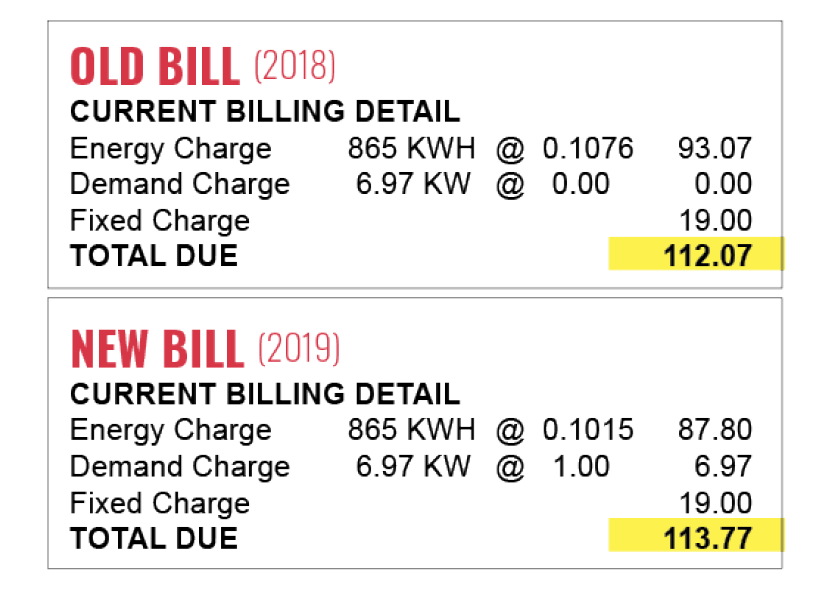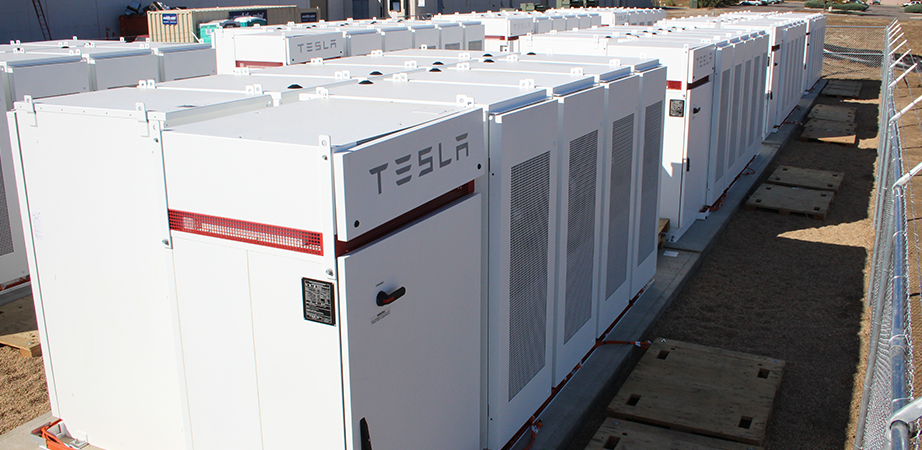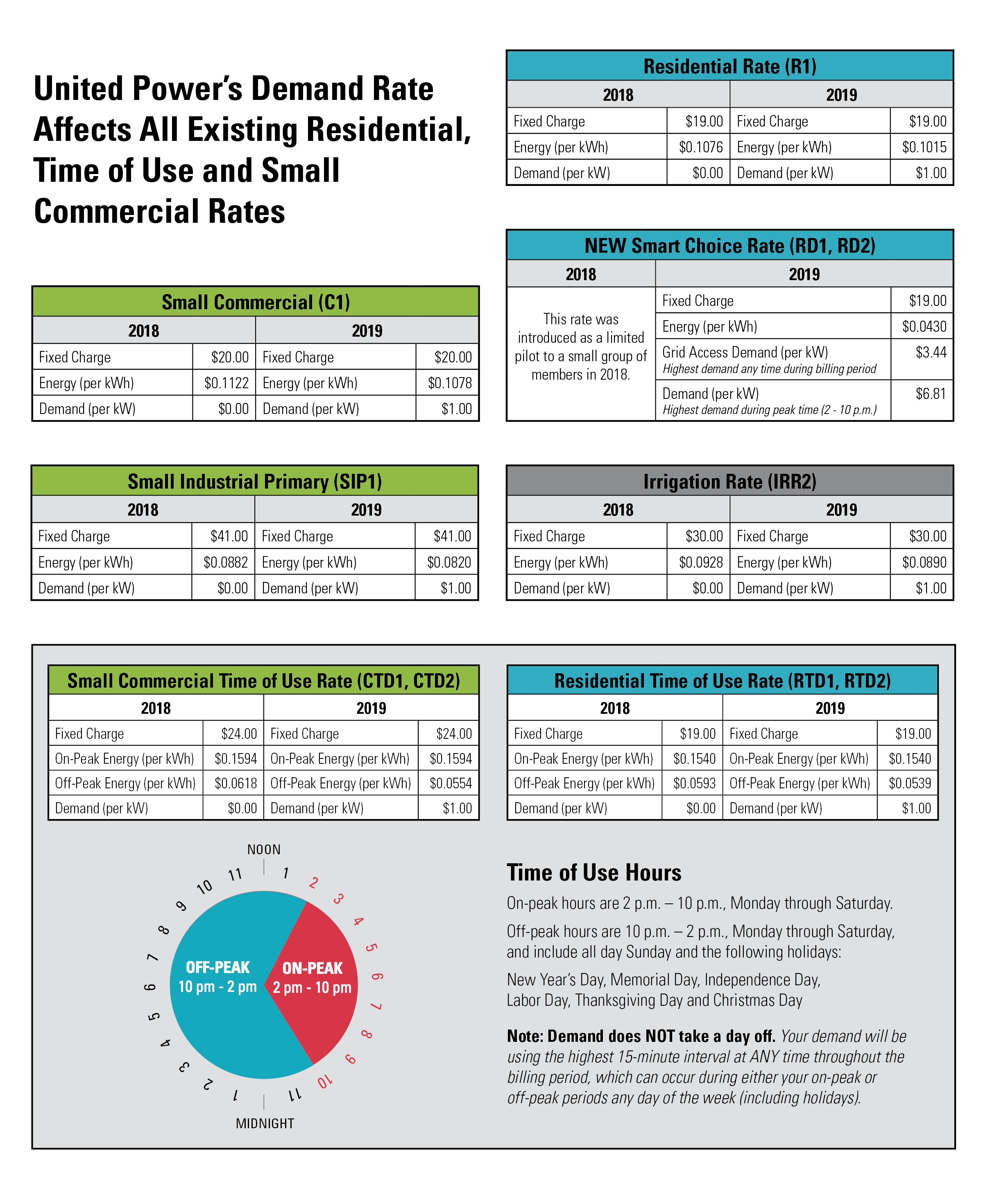/sites/default/files/styles/news_card_553x430_/public/news/Jan2019_NL_Rates.png?h=45932144&itok=KW7a9GOa
In several newsletters in 2018, we’ve discussed the new rate structure and a rate increase of 1.5-2% that goes into effect on January 1, 2019. It’s important to understand that while the rate change is effective for energy usage beginning on January 1, 2019, members won’t see the changes reflected on their bills until their February statements.
The new rate structure, which breaks apart the energy and demand components into separate charges, allows us to more fairly charge members for both their energy consumption and their impact on the delivery grid. In the past these two costs were recovered through a blended rate, but with more accurate metering we can now utilize each members’ demand to correctly allocate those costs.
“From a rate standpoint, we have the right information to correctly charge our members for their impact on the grid and the energy they use,” stated Dean Hubbuck, Director of Power Supply and Rates. “We have put together a rate that should put the power to control electric costs into the hands of our members.”
What is Demand?
Demand is how much capacity you need at any one time to serve the needs of your home or business during the billing period. United Power measures demand in 15-minute intervals, and members will be billed for their single highest 15-minute interval of consumption over the billing period. It is measured in kilowatts (kW) and your highest interval can occur at any time of the day or night.
How Much Will the Demand Charge Cost Me?
 Demand has been reported on billing statements since August of 2018, but without a corresponding dollar amount attached to the line item. In 2019 members will be charged $1 per kW for the highest 15-minute interval of consumption over the billing period. So, if your demand is 6.97 kW, you would see a charge of $6.97 for this line item.
Demand has been reported on billing statements since August of 2018, but without a corresponding dollar amount attached to the line item. In 2019 members will be charged $1 per kW for the highest 15-minute interval of consumption over the billing period. So, if your demand is 6.97 kW, you would see a charge of $6.97 for this line item.
To offset the demand charge, the 2019 rates also include a corresponding reduction the cost of energy. Now members can affect their electric bill in two different ways – by staggering use of appliances to reduce demand or by simply using less energy. So, while the rate change increases rates from 1.5-2% overall, members will have more power to control their bill than in the past.
What Affects my Demand?
Major appliances used for heating and cooling, cooking and laundry have the greatest impact on your energy use and your demand. The more appliances you operate at once, the higher your capacity needs are, which will result in a higher demand charge on your bill. Depending on your home, family size and appliances, your demand will vary, and your highest demand season may be different from other members.
How Can I Manage my Demand?
 Staggering the use of major appliances will be the easiest way to manage your electric bill under the new rate structure. When you consistently stagger the use of major appliances so they don’t run at the same time, you can keep your demand low. Make it easier by utilizing technology that helps you offset energy use like timers, delay start settings, mobile apps, and programmable thermostats. In the graph below, the red line represents demand.
Staggering the use of major appliances will be the easiest way to manage your electric bill under the new rate structure. When you consistently stagger the use of major appliances so they don’t run at the same time, you can keep your demand low. Make it easier by utilizing technology that helps you offset energy use like timers, delay start settings, mobile apps, and programmable thermostats. In the graph below, the red line represents demand.
Here are some helpful tips to manage your demand:
- Run the dishwasher after you’re done cooking dinner. Even better, use the delay start feature so your dishwasher runs later at night while everyone is in bed.
- Start your clothes washer before you go to bed in the evening, and then run the dryer after everyone has finished cooking breakfast the following morning.
- Grill outside or use small cooking appliances if the air conditioning is running. (Bonus: you won’t overheat your kitchen on a hot day!)
- Set your electric vehicle charger to run after you’ve you turned off other appliances for the day.
The changes to the rates are also complemented by a new Smart Choice Rate that takes the demand concept a step further. This new rate provides two different demand charges, and a much lower energy charge than with any other rate. The higher demand charges and lower energy charges may work well for a member who is willing to shift their demand throughout the day and night, and actively monitor their use.
How Can I Learn More About My Demand & Energy Usage?
In the past year United Power has rolled out access to the Power Portal, a way for members to look at their energy use in near real time. The portal provides information about when the member is using power in 15-minute increments as early as the previous day. This is a powerful tool to help members manage their energy use and see how they are impacting the power grid. Used in tandem with the demand rates, the Power Portal will provide the information members need to make good energy choices. As always, members can call our Energy Management team if they need more information about how they use power, and to learn more about how they can affect their power bills.
To View Demand in the Power Portal:
- Click “My Consumption Data” and then select “Current Month” and “Billing Month.”
- Turn on the orange Demand line using the controls below the weather data.
- The orange line is your Demand, and the orange diamond is your highest Demand to date, which occurred on December 3rd in this example.
- Click on that day to view each 15-minute interval to zero in on the exact time your demand was reached.
- From the Daily View, you can hover over the peak demand (orange diamond) and it will give you the interval (14:15 or 2:15 p.m.) and the kW reached (7.064 kW).
You will be billed on your single highest 15-minute interval each month at $1 per kW. In this scenario, the demand charge (to date) would be $1/per kW x 7.064 kW = $7.06. If demand exceeds this amount before the end of the billing cycle, you would be billed at that higher amount.


 Demand has been reported on billing statements since August of 2018, but without a corresponding dollar amount attached to the line item. In 2019 members will be charged $1 per kW for the highest 15-minute interval of consumption over the billing period. So, if your demand is 6.97 kW, you would see a charge of $6.97 for this line item.
Demand has been reported on billing statements since August of 2018, but without a corresponding dollar amount attached to the line item. In 2019 members will be charged $1 per kW for the highest 15-minute interval of consumption over the billing period. So, if your demand is 6.97 kW, you would see a charge of $6.97 for this line item. Staggering the use of major appliances will be the easiest way to manage your electric bill under the new rate structure. When you consistently stagger the use of major appliances so they don’t run at the same time, you can keep your demand low. Make it easier by utilizing technology that helps you offset energy use like timers, delay start settings, mobile apps, and programmable thermostats. In the graph below, the red line represents demand.
Staggering the use of major appliances will be the easiest way to manage your electric bill under the new rate structure. When you consistently stagger the use of major appliances so they don’t run at the same time, you can keep your demand low. Make it easier by utilizing technology that helps you offset energy use like timers, delay start settings, mobile apps, and programmable thermostats. In the graph below, the red line represents demand.
